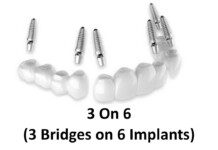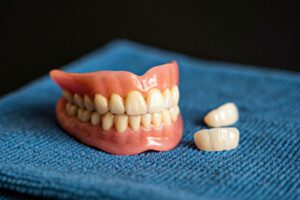
When many people want to fix their smile, they often get online and start searching for terms they’ve heard. Sometimes they know someone who had their mouth fixed and ask them what was done, then seek information on that treatment modality. The trouble is, there are several treatments that result in a beautiful smile, and they’re quite different. Sometimes it’s veneers, sometimes it’s implants, or crowns, or dentures. And they’re all different, although a great smile may be their common denominator.
Dentures and veneers are two treatments that can completely change a smile, but they are vastly different, and address very different patient needs.
Understanding the differences between dentures and veneers is crucial for individuals seeking to enhance their smile or restore or replace missing or damaged teeth. One is a dental restoration prosthesis, and the other, a cosmetic enhancement. Let’s dive into these:
Dentures are prosthetic devices designed to replace missing teeth and the surrounding tissues, helping restore functionality and improve facial aesthetics. On the other hand, veneers are thin, tooth-colored shells used primarily for cosmetic purposes to enhance the appearance of teeth that are discolored, worn down, or slightly misaligned. This article explores the types, purposes, and benefits of both dentures and veneers, helping individuals make informed decisions based on their specific dental needs.
What are Dentures?
Dentures are designed for people missing, or soon-to-be missing all their teeth. They replace both missing teeth and the surrounding tissues, and rest on the gums. They are custom-fitted to each individual’s mouth to ensure comfort and functionality. Dentures help restore the ability to chew and speak properly and improve facial aesthetics by providing support to the lips and cheeks, preventing the sagging that can occur with tooth loss. They are typically removable, making them easy to clean and maintain.
Types of Dentures:
-
- Partial dentures are used when some or many teeth are missing, but there are still natural teeth remaining in the upper or lower jaw. They consist of artificial teeth attached to a gum-colored acrylic base, which may be supported by a metal framework. Partial dentures are designed to fill in the gaps left by missing teeth, preventing the remaining teeth from shifting and maintaining the integrity of the dental arch. They are typically held in place by metal clasps that attach to the natural teeth. These are removable and need to be removed and cleaned daily, as well as after you eat.
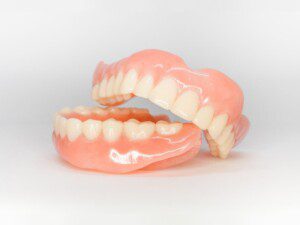
2. Complete Dentures:
Complete dentures, also known as full dentures, are used when all the teeth are missing in either the upper or lower jaw, or both. They are crafted from acrylic resin and sometimes combined with metal for additional strength. The upper denture covers the roof of the mouth, while the lower denture is U-shaped like a horseshoe to accommodate the tongue. Complete dentures rely solely on suction and sometimes denture adhesives to stay in place.
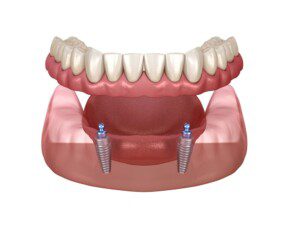
3. Implant Dentures/Removable:
This type of denture is often referred to as a snap-in denture. It is supported by dental implants (posts surgically placed into the jawbone to support it, like tooth roots support our natural teeth), but is removable. This is considered a step up from traditional dentures, but not as secure as implant fixed dentures (below).
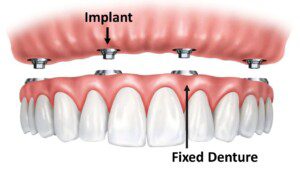
4. Implant Dentures/Fixed (Non-Removable):
These dentures can’t move around in your mouth because they are fixed/attached to dental implants and screwed into place, making them feel much more like “real teeth” than other dentures. This makes them much easier to chew and speak with comfortably than traditional dentures. This type of denture requires more implants than a removable implant denture does, and costs more, but is the denture option that results in the most secure and natural feel. Another bonus: you don’t have to take them out to clean them.
(We have a full page for each of these, in the links provided for each description above.)
 When and Why Are Dentures Typically Used?
When and Why Are Dentures Typically Used?
Dentures are typically used when an individual has lost several or all of their natural teeth due to tooth decay, periodontal disease, or trauma. They are often considered when other dental restoration options, such as bridges or dental implants and crowns, are not feasible due to the extent of tooth loss or underlying oral health issues. Dentures restore oral functionality, enabling individuals to eat a wider variety of foods and speak clearly. They also play a critical role in maintaining facial structure and aesthetics by supporting facial muscles and soft tissues.
What are Veneers and When Are They Typically Used?
Veneers are thin shells made from tooth-colored materials that are custom-designed to fit over the front surfaces of teeth. They are primarily used for cosmetic purposes to enhance the appearance of teeth that are discolored, worn down, chipped, misaligned, or irregularly shaped. Veneers provide a natural and aesthetically pleasing look, as they can be color-matched to existing teeth and shaped to create a uniform and harmonious smile.
Types of Veneers:
- Porcelain Veneers:
Porcelain veneers are crafted from high-quality dental ceramic that closely mimics the translucency and texture of natural tooth enamel. They are custom-made in a dental laboratory to fit each tooth precisely and are bonded to the teeth with strong dental cement. Porcelain veneers are known for their durability, stain resistance, and ability to reflect light similar to natural teeth, providing a long-lasting and realistic appearance.
- Composite Veneers:
Composite veneers are made from a tooth-colored resin material that is applied directly to the teeth and sculpted to the desired shape by the dentist. They are typically less expensive than porcelain veneers and can be completed in a single dental visit. While composite veneers offer an effective and aesthetic solution for minor cosmetic issues, they may not be as durable or stain-resistant as porcelain veneers. Being made of composite/resin, they tend to stain much more easily and are expected to need replacement more frequently.
The Aesthetic and Protective Role of Veneers:
Veneers play a dual role in both enhancing the aesthetics of the smile and providing a protective layer for damaged or weakened teeth. They can address a wide range of cosmetic concerns, such as discoloration, chips, gaps, and minor misalignments, transforming the appearance of the teeth and boosting confidence. Additionally, veneers can help protect the underlying tooth structure by covering and sealing cracks or worn enamel, potentially reducing the risk of further damage.
Differences in Usage
Functional Purposes of Dentures vs. Veneers:
As you can see, dentures and veneers serve VERY different functional purposes based on the dental needs they address. Dentures are primarily functional prosthetics designed to replace missing teeth, and Veneers are primarily cosmetic enhancements that improve the appearance of existing, otherwise healthy teeth teeth.
Conclusion
Dentures and veneers serve distinct purposes in the realm of dental care, each offering unique advantages and challenges. Dentures are essential for restoring oral functionality and appearance when teeth are missing, making them ideal for individuals with extensive tooth loss. Veneers provide a cosmetic solution for enhancing the aesthetics of existing teeth, addressing minor imperfections without replacing them.

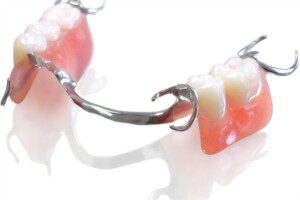
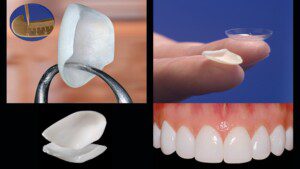 When and Why Are Dentures Typically Used?
When and Why Are Dentures Typically Used?